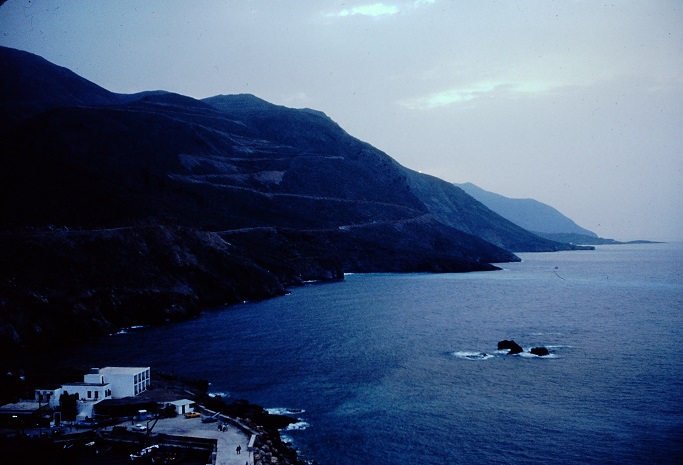
Another flashback to my hippie backpacking days on Crete, camping and exploring the rugged south coast.
NOTE: Of course, Thor and I had to make another trip to Greece, as he’s fallen as much in love with the islands as I am. This time, in addition to other island-hopping, I wanted to return to Crete after 37 years. My first months-long trip was as a hippie backpacker, camping in the ruins and falling under the spell of the mysterious, vanished Minoan culture. This time, I got to introduce Thor to “glorious Kriti” and research more settings for my novel-in-progress, THE ARIADNE DISCONNECT. This new blog series started October 19, 2019, and will continue every Saturday.
“The best laid plans of mice and (wo)men….” In last week’s post, I promised photos and stories of Thor’s and my arrival in South Crete, but alas my computer decided otherwise. Remember when we actually believed that computers were going to be as friendly as the “Star Trek” cheerily helpful, all-knowing AI? My newish computer keeps throwing nasty surprises in my path, eating up way too much time and energy to address, so today we’re going to revisit another rough-and-ready episode from my early days on Crete. Tighten your backpack straps and join me!
After arriving by overnight ferry on the north coast of Crete, my partner Jim and I had followed a winding thread across the mountainous island, involving some rattletrap bus rides, cheerful misdirections, and a 3-hour stumble in the deepening dusk down a rocky cliffside trail carrying a heavy backpack. We were heading toward a remote cove and the tiny settlement of Loutro, accessible only by this cliff trail or boat.
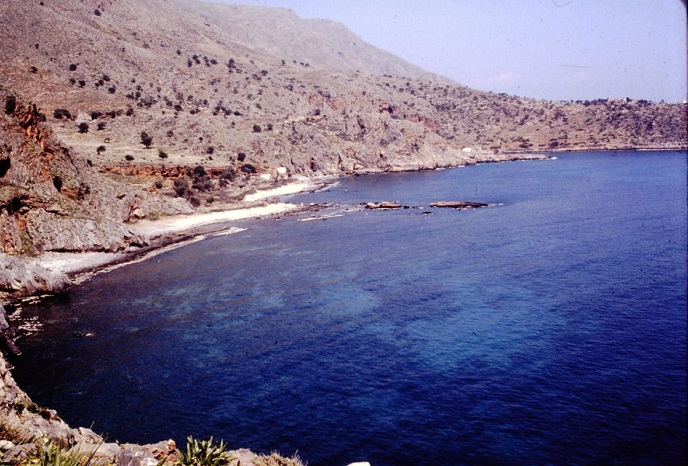
More than a journey through the rugged Cretan landscape, we’d been taking a trip through time—way back to the Minoans or Keftiu, the later Greeks, Romans, Byzantines, Saracen pirates, Venetians, and Turks, and finally the World War II German invasion only an eyeblink earlier in history. We set up camp on the rocky shore above the ruins of what was revealed the next morning to be Venetian fortifications.

Eager to explore the amazingly clear, purple-blue sea, I plunged into some free-diving in the very cold water and spotted what appeared to be submerged, carved stone columns. (This photo is of a later dive, following the lure of the blue.)
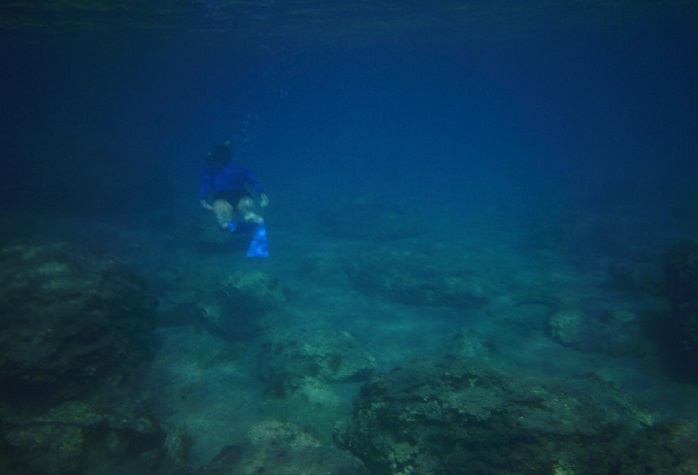
The next day, eager to explore, Jim and I hiked over the west side of the peninsula in search of the path to a cove with a white marble beach we had heard about from a German scholar at a taverna in the village. As usual in this broken rock landscape, we lost the trail and ended up in a cross-country scramble in sandals. The pumice-type rocks clung to our sandal soles for a good grip, but if we slipped were painfully sharp. The steep, barren slopes supported only scrubby thorn bushes, a few tiny wildflowers, and the occasional beautiful old olive tree. And just when I felt we were miles from any human traces, we rounded a boulder to meet a local shepherd with fringed head-scarf, baggy pants, and tall leather boots, sauntering among his flock with a staff across his shoulders and dog by his side. And there, too, nestled in the stones, was another of the ubiquitous tiny shrines: a metal box open in the front and sheltering a religious icon and perhaps a cross, with an olive oil lamp burning as a sign of devotion.

Our unintended detour took us partway up the cliffside, where we stumbled onto a winding stretch of ancient Roman road, finely engineered of smooth paving stones and leading to another tiny village perched high up a narrow gorge.
From my journal: We share the splendid view with the goats. I envy them—even the youngest bounces effortlessly from rock to rock. There seems to be no spot on the island free of their droppings. I well believe what I’ve read, that Greece could be reforested in 70 years if not for the voracious goats that the people cannot part with. I understand—the critters are somehow endearing, and comical.
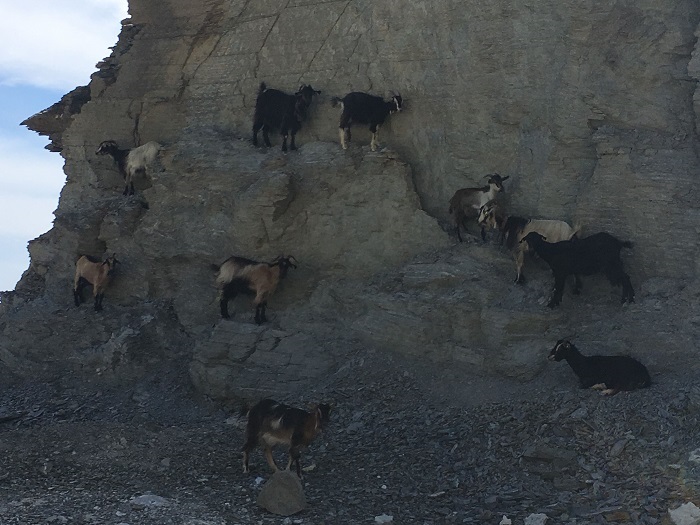
As I mentioned last time, on a later hike along the coast, we fell in with a goat herder who walked with us and gave me the “heroic epithet” of Sara Kri-Kri for the wild Cretan goats. Maybe he was impressed by my insanely huge packback! (Indulge me for sharing this photo again; it always makes me laugh even as I sigh for my strong young legs.)
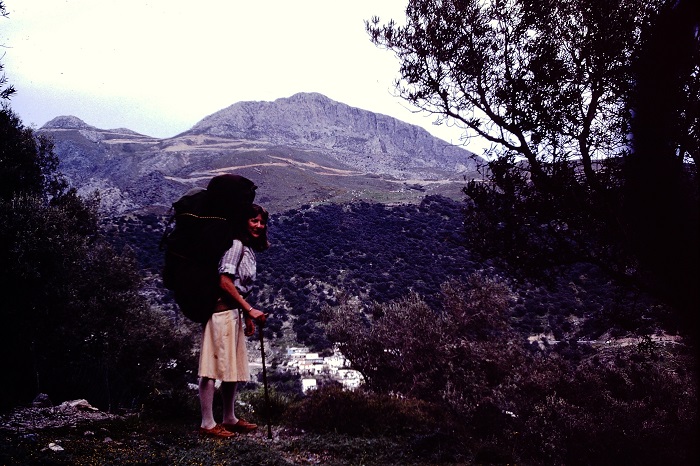
More rambling around the hillsides brought us to the ruins of a stone fort overlooking Loutro, which was apparently built by the Turks in the 1800s to quell uprisings after they had kicked out the Venetians.

The next morning we deemed washing day, and since the village offered no such services, we took our dirty clothing down to the shore where one of the freshwater springs emptied into the sea. We beat our clothes on the rocks in an age-old routine, then hung our wet laundry on a line back at camp.

We left our still-damp clothes on the line overnight, but woke early in the morning to whipping wind flapping the tent and laundry. Leaping naked from the tent to gather up the line and anything tumbling loose in camp, we saw another tourist tent below us lifting into the air and sailing into the cove, now an angry cauldron of whitecaps. We double-anchored our tent with rocks and hunkered inside to wait out the storm—a reminder that these seas and rugged shorelines can be unforgiving. We passed the time reading passages from The Iliad and inventing Homeric epithets: Jim became Demetrios the Hard, and he decided that I was Sara of the Mocking Tongue. Hmm.
After the storm passed and the sky cleared to vibrant blue again, we sat on the steps of a small whitewashed chapel soaking in more vistas of stark pale stone and cobalt sea. Falling into another reverie, I wrote in my journal:
I’m actually here, in Greece. After the forested cocoon of our damp, cool Pacific Northwest, these bare expanses and the clarity of air and sea are sweeping me clean like the Meltemi wind. The hush at times summons the ghosts of all the civilizations that have come and gone here, leaving the broken shrines of their gods. Is it only the sacred mystery our literature has invested in Golden Greece, or is it something inherent in this land itself? I seem to be starting at the fringe of the mystery and will wind my way to the heart of the labyrinth, like Ariadne. But maybe it’s just the opposite, since by starting here on Crete I’m already at the heart of the original Greek civilization, on the grounds of the Keftiu, or Minoans. From here, I hope to unfurl into this expansive freedom of light.
Please excuse some poetic grandiosity from my 20ish self. There’s something about Greece that simply possesses one that way.
So, letting time flow around me, feeling the warmth of the stones soak into me, I sat listening to ancient whispers until blue dusk settled over the chapel.
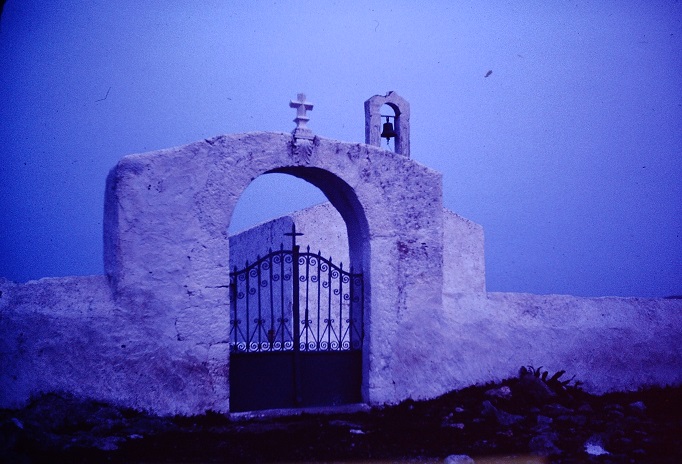
*****
You will find The Rambling Writer’s blog posts here every Saturday. Sara’s latest novel from Book View Cafe is available in print and ebook: The Ariadne Connection. It’s a near-future thriller set in the Greek islands. “Technology triggers a deadly new plague. Can a healer find the cure?” The novel has received the Chanticleer Global Thriller Grand Prize and the Cygnus Award for Speculative Fiction. Sara has recently returned from another research trip in Greece and is back at work on the sequel, The Ariadne Disconnect. Sign up for her quarterly email newsletter at www.sarastamey.com

1 thought on “The Rambling Writer Returns to Crete, Part 4: South Coast Memories”